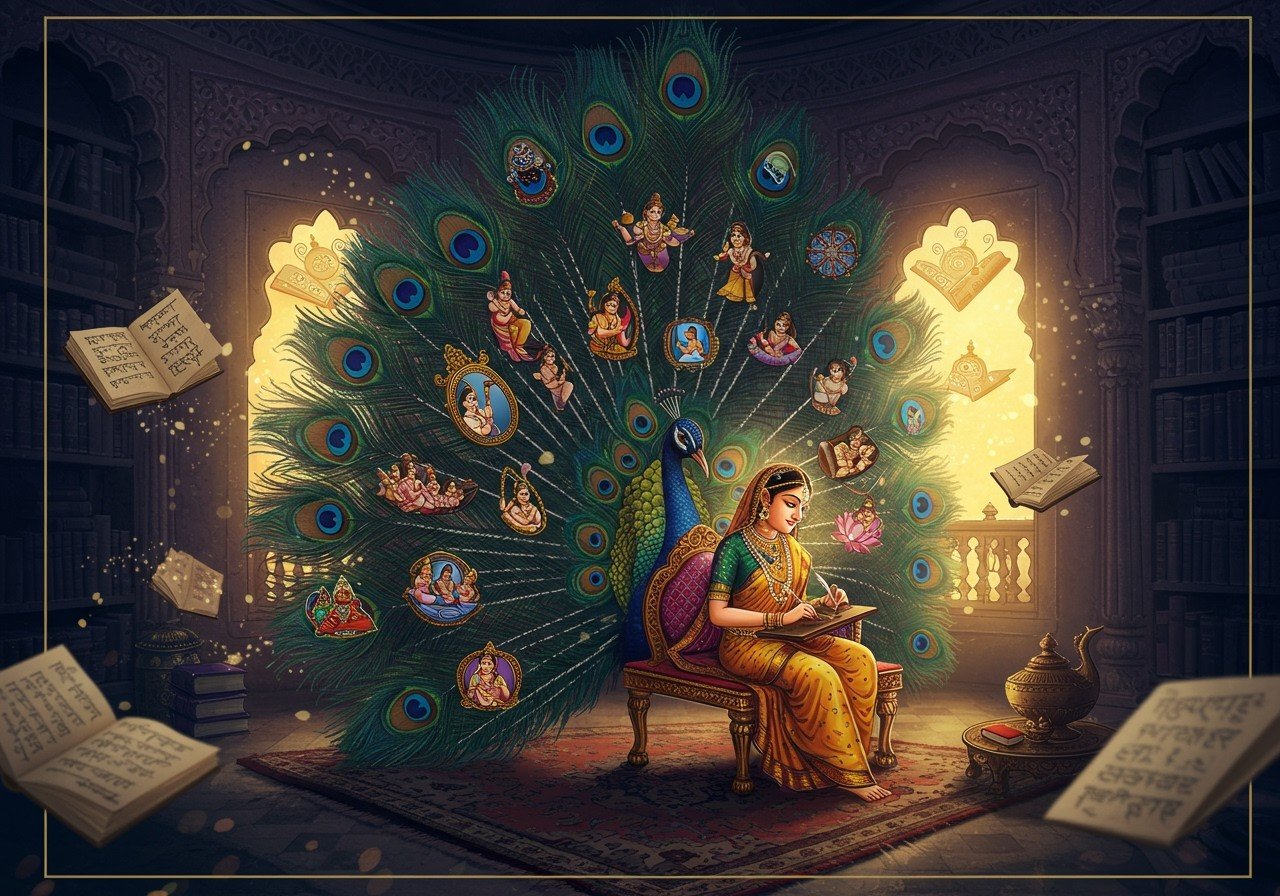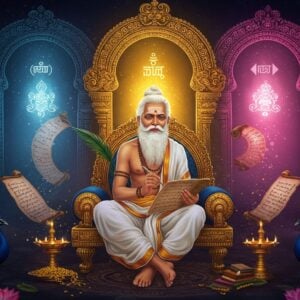
Indian literature, a treasure trove of vibrant storytelling, is deeply interwoven with traditions that lend depth and beauty to its language. Alankaras, figures of speech, play a pivotal role in enhancing this beauty, particularly in poetry and prose. They hold immense cultural significance, especially within regional languages like Kannada, acting as guardians of our heritage and adding expressiveness to both written and oral traditions.
Understanding Alankaras
Alankaras are literary devices that elevate language, making it more captivating and meaningful. Their roots lie in classical Indian literature, where they were meticulously developed to create vivid imagery, infuse rhythm, and evoke a spectrum of emotions. Used in both written and spoken forms across various Indian languages, Alankaras help convey deeper meanings, adding layers of nuance to literature.
Think of alankaras as the spices in a delicious Indian dish. Just as spices enhance the flavour and aroma, alankaras enrich the language, making it more appealing and memorable. They help us connect with the essence of the story or poem on a deeper level.
Types of Alankaras in Indian Literature
Indian literature cherishes Alankaras, those figures of speech that breathe life into language. Essential in poetry and prose, they paint vivid pictures in our minds and stir our emotions. By understanding the different types of Alankaras, we gain a deeper appreciation for the richness and beauty of Indian writing. It’s like discovering the secret ingredients that make a masterpiece so captivating.
Shabda Alankaras
Shabda Alankaras work their magic through sound, creating a musicality in verses that resonates with our senses. Anuprasa, one popular type, uses alliteration, that delightful repetition of consonant sounds, to make lines memorable. Think of the rhythmic flow of “Peter Piper picked a peck of pickled peppers”—that’s the charm of alliteration at play. Another example is Yamaka, which involves the repetition of words or phrases, adding a rhythmic pulse that makes poetry more engaging. It’s like the steady beat of a drum, keeping us hooked to the rhythm of the words.
Yamaka Alankara
Yamaka stands out as a prominent Shabda Alankara. It enhances the beauty of poetry by repeating words or sounds, creating a musical flow that captivates the listener. Famous Kannada poets have often woven Yamaka into their works, enhancing the emotional depth and rhythm of their verses. Kumara Vyasa’s poems beautifully demonstrate the effect of Yamaka, showing how it can add both rhythm and emotion to poetry. Imagine a classical Indian raga, with its recurring motifs and melodies—Yamaka brings a similar sense of harmony and resonance to poetry.
Artha Alankaras
Artha Alankaras, on the other hand, focus on meaning, conveying complex ideas and emotions with grace and precision. Upama, a simile, compares two distinct things using “like” or “as,” enriching descriptions and painting vivid images. For example, “He is as brave as a lion” creates a powerful image in our minds. Rupaka, a metaphor, makes an implied comparison without using direct words like “like” or “as,” giving language depth and complexity. Saying “He is a lion in battle” conveys the same message but with more impact. Atishayokti is hyperbole, a delightful exaggeration used for emphasis. For instance, saying “I’ve told you a million times” adds humour and emphasis to a point.
Kannada Literature’s Alankaras
Kannada literature, in particular, is richly adorned with Alankaras, adding depth and diversity to its poetic landscape. Poets like Pampa and Ranna have masterfully used these devices, their works reflecting cultural nuances and emotional profundity. Alankaras, in essence, help convey the very essence of tradition and heritage. These literary devices act as windows into the Kannada soul, reflecting its rich tapestry of emotions and experiences.
Cultural Significance
Alankaras serve as guardians of Indian cultural values, deeply embedded in our literary heritage. They appear in revered religious texts, conveying moral teachings and philosophical insights. In oral storytelling, Alankaras captivate audiences, etching tales into memory. Their relevance persists in modern literature, creating a bridge between traditional and contemporary expressions. Imagine the grand epics of the Ramayana and Mahabharata, narrated with passion and embellished with Alankaras—these figures of speech bring the stories to life and keep our cultural heritage alive.
These literary devices not only enhance the beauty of language but also serve as a thread connecting us to our rich cultural heritage. Exploring Alankaras in Indian literature opens up a world of beauty and tradition, waiting to be embraced and appreciated.
How Poojn Helps with Regional Alankara Varieties
At poojn.in, we understand the significance of regional variations in traditional items. We offer a curated collection of Alankaras, catering to diverse regional preferences across India. Our offerings include various regional styles of ornaments and decorative items used in deity worship, ensuring authenticity and cultural relevance.
- Chandika Haar (Gujarati): Available in both traditional and contemporary designs, celebrating the rich heritage of Gujarat.
- Chandramaala (Telugu): Crafted with authentic materials, reflecting the artistic traditions of the Telugu region.
- Chandni Haar (North Indian): Perfect for adorning deities in temples and home shrines, adding a touch of North Indian elegance.
- Chandrahar (Marathi): Made with high-quality materials, embodying the cultural essence of Maharashtra.
- Chandra Malai (Tamil): Available in various sizes and styles, catering to the unique traditions of Tamil Nadu.
At Poojn.in, you can easily explore these regional variations, aided by detailed product descriptions in multiple languages. We provide pan-India delivery and expert guidance on selecting the perfect Alankara for your specific needs. For personalized assistance in choosing the right Alankara:
- Call us at 03369029784
- WhatsApp us at 9476142738
- Visit www.poojn.in for our complete collection
Our team of experts is dedicated to helping you select authentic Alankaras that perfectly match your regional customs and traditions. We ensure each piece meets traditional specifications while offering the convenience of online shopping and doorstep delivery. Shop Now: Visit our Alankara collection at www.poojn.in/alankaras.
Embracing the Beauty of Alankaras
Understanding Alankaras in Indian literature is like opening a window into a world brimming with beauty and tradition. These figures of speech are more than just literary tools; they’re a way to connect with our cultural roots and express emotions with profound depth. From the musical charm of Shabda Alankaras to the insightful meanings conveyed by Artha Alankaras, each type adds its unique flavour to our language, making it richer and more evocative. As you explore these enchanting devices, you not only appreciate the artistry of Indian poets but also become a part of a storytelling legacy cherished for generations.
Ramcharitmanas: A Deep Dive into Devotion and Epic Narrative
Hanuman Chalisa: Meaning, Benefits, and Recitation
FAQs on Types of Alankaras: A Complete Guide with Examples
What are Alankaras in literature? Alankaras are figures of speech, like similes and metaphors, used to make language more expressive and beautiful. They create vivid imagery and add depth to poetry and prose, making the writing more engaging and memorable.
How many types of Alankaras are there? Broadly, there are two main categories: Shabda Alankaras, focusing on sound, and Artha Alankaras, focusing on meaning. Within these categories, numerous sub-types exist, each adding its own unique touch to literary works.
Can you explain what Shabda Alankaras are? Shabda Alankaras deal with the sound aspect of words. They utilize techniques like alliteration (Anuprasa) and repetition (Yamaka) to create musicality and rhythm in the text, making it pleasing to the ear.
What is Yamaka Alankara? Yamaka Alankara is a specific type of Shabda Alankara involving the repetition of words with different meanings. This clever wordplay adds a layer of meaning and enhances the rhythmic quality of the verse, making it more engaging.
What are Artha Alankaras? Artha Alankaras are figures of speech that focus on the meaning of words. These include comparisons like similes (Upama) and metaphors (Rupaka) and exaggerations (Atishayokti), used to convey deeper meanings and evoke strong emotions. They bring abstract concepts to life and make the writing more impactful.
Why are Alankaras important in poetry? Alankaras are the poet’s toolkit for adding depth, beauty, and emotional resonance to their work. They paint vivid pictures in the reader’s mind, make complex ideas easier to grasp, and create a lasting impression. They are the secret ingredient that transforms ordinary language into powerful poetry.
Are there specific Alankaras used in Kannada literature? While many Alankaras are common across different Indian languages, Kannada literature has its unique variations and adaptations. These reflect the specific linguistic and cultural nuances of the Kannada language and tradition, making it distinct and rich.
Where can we find examples of Alankaras? Classical Indian poetry and literature are treasure troves of Alankaras. Many modern writers also embrace these traditional figures of speech, adding depth and beauty to their work. You can find numerous examples in ancient epics, religious texts, and even contemporary poems and stories. For up-to-date information on figures of speech, refer to recent search results.


